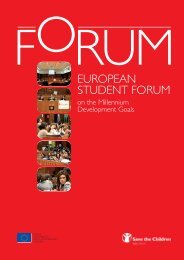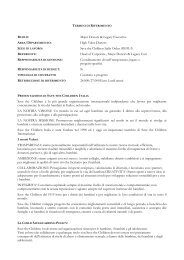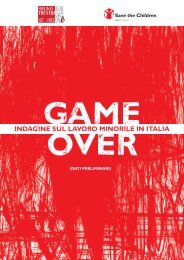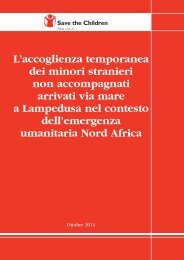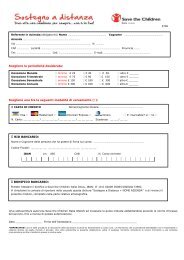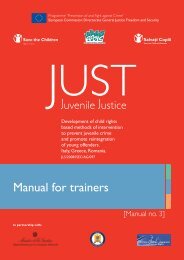<strong>FINAL</strong> <strong>REPORT</strong>Development of a Child Rights Methodology to Identify and Support Child Victims of TraffickingEXECUTIVE SUMMARYGENERAL OVERVIEW OF THE PROJECT1.The AGIS Project and <strong>the</strong> Final ReportThis chapter describes <strong>the</strong> 24-month project, “Development of a child rightsmethodology to identify and support child victims of trafficking”, supported by <strong>the</strong>European Commission within <strong>the</strong> AGIS Programme 2005.It also presents <strong>the</strong> scope and organisation of <strong>the</strong> Final Report of <strong>the</strong> project, as well as<strong>the</strong> child rights based approach used in its implementation. Finally, it clarifies <strong>the</strong>terminology used.<strong>FINAL</strong> <strong>REPORT</strong>Development of a Child Rights Methodology to Identify and Support Child Victims of TraffickingAccording to <strong>the</strong> “Bundeslagebild Menschenhandel 2006” (national report on humantrafficking of <strong>the</strong> Federal Bureau of Investigation), in 2006, 775 were <strong>the</strong> criminalproceedings based on trafficking for <strong>the</strong> purpose of sexual exploitation. 62 were <strong>the</strong>cases of children between 14 and 17 years of age, while 320 victims were between 18 and20 years old. 98,5% of <strong>the</strong> cases involved girls, mainly from <strong>the</strong> Czech Republic,Romania, Poland, Slovakia, Russia, Bulgaria, Thailand and Nigeria. None<strong>the</strong>less, 28 of62 victims aged 14-17 years, were from Germany. Girls are recruited through <strong>the</strong> use ofviolence or are promised jobs abroad or, where <strong>the</strong>y are already involved in prostitutionin <strong>the</strong> country of origin, <strong>the</strong>y are promised higher incomes abroad.<strong>Children</strong> exploited in illegal activities are between 8 and 14 years of age, thus under <strong>the</strong>age of criminal consent. In general <strong>the</strong>y are boys from Central and Eastern Europeancountries, e.g. Romania and Albania. In Germany, <strong>the</strong>y live especially in <strong>the</strong> Ruhr area,Stuttgart, Hamburg and Berlin. Most of <strong>the</strong> victims come from poor countries/regionsand very poor families who were probably aware of <strong>the</strong>ir involvement in illegal activitiesabroad, though generally not <strong>the</strong> actual working conditions and <strong>the</strong> exploitative situation.PART ICHILD TRAFFICKING: <strong>REPORT</strong> ON RESEARCH FINDINGSPart I provides a summary of <strong>the</strong> research findings as resulting from <strong>the</strong> research activitiesconducted in <strong>the</strong> AGIS project in Bulgaria, Germany, Italy and Romania.2. BulgariaBulgaria is a country of origin and transit and, to a lesser extent, a country ofdestination.As far as trafficking for sexual exploitation is concerned, child victims generally leave<strong>the</strong> country by private or public buses. On <strong>the</strong> trafficking routes, accompanying adults,in general ei<strong>the</strong>r recruiters or o<strong>the</strong>r intermediaries who work for <strong>the</strong> traffickers, change atso called “redistribution stations”. In <strong>the</strong> case of Roma children, it is very likely that <strong>the</strong>yare accompanied ei<strong>the</strong>r by <strong>the</strong>ir parents or relatives or travel with <strong>the</strong>ir parents’ formalauthorisation and <strong>the</strong>ir legal documents. The majority of child victims of trafficking or atrisk of becoming victims of trafficking for <strong>the</strong> purpose of sexual exploitation are agedbetween 16 and 18 years. They are mainly female, but can also be male.Recruiters are mainly acquaintances or friends and sometimes relatives who frequentlypromise well paid jobs in Western European countries. In addition, children sometimesfollow-up real job advertisements in newspapers, offering positions such as models,barmen, waiters, or chambermaids.In <strong>the</strong> case of trafficking for exploitation in illegal activities and begging, <strong>the</strong> majorityof child victims are aged between 8 and 14 years. Those exploited in forced labour(mainly in agricultural work) are aged between 16 and 18 years. Victims falling in <strong>the</strong>three categories are mainly male and most of <strong>the</strong>m are Roma who are recruited with <strong>the</strong>involvement of <strong>the</strong>ir family.3. GermanyGermany is a destination country, transit country and also country of origin of childvictims of trafficking. Most victims come from Eastern and Central European countries.According to <strong>the</strong> research findings, in many cases children get into <strong>the</strong> traffickingsituation through <strong>the</strong>ir own families, close relatives or o<strong>the</strong>r persons in a position oftrust. O<strong>the</strong>rwise, street children are often contacted directly by <strong>the</strong> traffickers in <strong>the</strong>ircountry of origin. While in some cases traffickers cross borders with child victims,declaring to be <strong>the</strong> parents, in some o<strong>the</strong>r cases, <strong>the</strong>y hand <strong>the</strong> children over to a contactperson from Germany at <strong>the</strong> border. Child victims travel to Germany by bus, train or carand only seldom by plane.4. ItalyItaly is mainly a country of destination and of transit of child victims of internationaltrafficking. None<strong>the</strong>less, internal trafficking is also increasing.The main targets of trafficking for <strong>the</strong> purpose of exploitation in prostitution in Italyare adolescent girls and those just come of age, from Nigeria and Cameroon and fromEastern European countries, mainly Romania and Moldova, but also Bulgaria, CzechRepublic, Albania, Serbia and Croatia.Adolescent girls from Nigeria are generally forced to prostitute <strong>the</strong>mselves on <strong>the</strong>streets. There is also an increasing number of adolescent girls and young adults fromCameroon who are recruited by Nigerian traffickers.Adolescent girls mainly from Romania and Moldova, but also from all <strong>the</strong> EasternEuropean countries mentioned above, are attracted to <strong>the</strong> possibility of travelling to orfinding work in a Western European country. In <strong>the</strong>ir country of origin, possiblerecruiters for trafficking are many and varied, from acquaintances to boyfriends andfemale friends to family members. The girls are usually trafficked to Italy by car or bus.In Italy, <strong>the</strong>se victims engage in prostitution on <strong>the</strong> streets and in apartments.Exploitation in illegal activities is not a well-known phenomenon in Italy, and victimsare not often identified as such, thus missing out on <strong>the</strong> support necessary for <strong>the</strong>irprotection and rehabilitation. Cases of international trafficking are of particular concern,and have been identified amongst <strong>the</strong> following profiles:• Roma <strong>Children</strong> from Romania, who are likely to be under 14 years of age, that is,under <strong>the</strong> age of criminal consent, hence not punishable with imprisonment if caughtwhile stealing. They are recruited in <strong>the</strong>ir country of origin, in agreement with <strong>the</strong>irfamily, who profits from <strong>the</strong>ir exploitation.• Roma adolescents: in <strong>the</strong> country of origin adolescents are convinced by <strong>the</strong> traffickersto engage in high-profit criminal activities, such as <strong>the</strong>ft, but in an independent way.<strong>Children</strong> travel on <strong>the</strong>ir own and may have correct papers giving guardianship to <strong>the</strong>driver of a coach and <strong>the</strong> person waiting for <strong>the</strong>m at <strong>the</strong> place of destination.• Adolescent boys from Senegal and Gabon: <strong>the</strong> phenomenon is apparently controlledby Mafia-type organisations who recruit boys in <strong>the</strong>ir country of origin, by deceit orwith threats, and organise <strong>the</strong>ir (illegal) travel to Italy by boat across <strong>the</strong>Mediterranean or with false documents by plane. In Italy, <strong>the</strong>se victims are involved indrug dealing on <strong>the</strong> streets and transportation of heavy drugs such as crack, cocaineand heroin.• Finally, according to <strong>the</strong> research findings, also adolescent boys from North Africancountries are exploited in Italy in illegal activities.From <strong>the</strong> research conducted in Italy also emerges that <strong>the</strong>re are children exploited inbegging, that is to say children who are forced to beg under such conditions as leave nodoubt as to <strong>the</strong> intentions of <strong>the</strong> exploiters: to profit from <strong>the</strong> child, and take advantageof <strong>the</strong>ir vulnerable state for <strong>the</strong>ir own benefit. In this case, Roma boys and girls fromRomania or former Yugoslav countries are most at risk of exploitation from adults with8 9
<strong>FINAL</strong> <strong>REPORT</strong>Development of a Child Rights Methodology to Identify and Support Child Victims of Trafficking<strong>FINAL</strong> <strong>REPORT</strong>Development of a Child Rights Methodology to Identify and Support Child Victims of Traffickingwhom <strong>the</strong>y have no family ties, and particularly those children and adolescents withsevere physical disabilities.Finally, while exploring <strong>the</strong> characteristics of exploitation of child labour in Italy itbecomes clear that this phenomenon is rarely linked to international nor internaltrafficking. Groups most at risk are adolescent boys from Bangladesh and Indiaworking on farms and boys of North African and Sub-Saharan origin, recruited foragricultural jobs in Italy.5. RomaniaRomania is a country of origin and transit and, to a lesser extent, a country ofdestination.According to <strong>the</strong> research findings, <strong>the</strong> majority of child victims of trafficking or at riskof becoming victims of trafficking for <strong>the</strong> purpose of sexual exploitation are girls,aged between 15 and 17. Despite this, it seems that <strong>the</strong> request for children of a youngerage is increasing. Most frequently, children trafficked for sexual exploitation are recruitedby acquaintances or friends and are promised jobs. Sometimes <strong>the</strong> parents <strong>the</strong>mselves orrelatives are involved in <strong>the</strong> trafficking of children. Ano<strong>the</strong>r recruitment manner, used toa lesser extent, consists in advertisements in <strong>the</strong> press for job offers abroad, especiallytargeting girls older than 16. The advertisements can also come from matrimonialagencies. The means of transportation are usually <strong>the</strong> traffickers’ cars. Depending on <strong>the</strong>network structure, trafficked children are accompanied by different persons for differentlegs of <strong>the</strong> journey until <strong>the</strong> moment when <strong>the</strong>y are handed over to <strong>the</strong> person that willhost and exploit <strong>the</strong>m. Very often, once children reach <strong>the</strong> destination countries, areconfined in closed places or closely monitored by <strong>the</strong> exploiter on <strong>the</strong> street and coercedand controlled through <strong>the</strong> use of violence.In <strong>the</strong> case of children trafficked for forced labor, begging and illegal activities,recruiters are Romanian nationals. <strong>Children</strong> are mainly approached on <strong>the</strong> street, atrailway and subway stations and in central areas in urban settings. Most frequently,children are recruited by <strong>the</strong> family’s acquaintances or friends, with <strong>the</strong> consent of <strong>the</strong>family. When recruiters approach <strong>the</strong> victims <strong>the</strong>mselves, offering <strong>the</strong>m good jobsabroad, children accept to go with <strong>the</strong> trafficker because <strong>the</strong>y hope to have a better life.Both in <strong>the</strong> case of involvement of <strong>the</strong> family or when children travel alone with <strong>the</strong>irtrafficker or recruiter, <strong>the</strong> most common means of transportation used to reach <strong>the</strong>destination countries are buses of specialised travel agencies and trains. In <strong>the</strong> destinationcountries, trafficked children generally work in <strong>the</strong> streets, which exposes <strong>the</strong>m to <strong>the</strong>risks of street life. They are mainly exploited in illegal activities, such as petty crimes andbegging but <strong>the</strong>re are also cases of children forced to work in agriculture, picking fruitsor vegetables (Germany, Spain, Austria) and selling flowers.PART IIIMETHODOLOGY FOR IDENTIFICATION AND SUPPORTOF CHILD VICTIMS OF TRAFFICKING7. Methodology for <strong>the</strong> identification and support of child victimsof trafficking (<strong>the</strong> AGIS methodology)The main aim of this AGIS project consisted in <strong>the</strong> development of a child rights basedmethodology to identify and support child victims of trafficking (hereinafter “<strong>the</strong> AGISmethodology”), which is presented in this Chapter. It includes 9 methodologicalframeworks and is divided in three sections:Section 1: on profiles and indicators for <strong>the</strong> identification of child victims of trafficking.Section 2: on cooperation, coordination and approach, including a list of child rightsprinciples applicable to procedures for cooperation on identification and support; amethodological framework to outline instruments of protection available in national legalsystems; a statement of good practices to be followed as far as <strong>the</strong> organisation, structureand approach are concerned; a methodological framework to guide <strong>the</strong> development ofrecommendations on operating procedures to be implemented, age assessmentprocedures and procedures to assess relations between children and accompanying adults.Section 3: on ethical and methodological principles applicable in interviews of presumedchild victims of trafficking.8. National seminarsOver <strong>the</strong> months from September to November 2007, 4 national seminars wereorganised in <strong>the</strong> four project countries, bringing toge<strong>the</strong>r relevant stakeholders workingin <strong>the</strong> field of child trafficking, including, law enforcement agents, NGO representatives,<strong>the</strong> judiciary and public institutions.In <strong>the</strong>se occasions, <strong>the</strong> AGIS methodology developed in this project was presented to <strong>the</strong>participants by <strong>the</strong> various project officers while experts from law enforcement agencies,NGOs, <strong>the</strong> judiciary and institutions, were invited to provide specific comments. Inaddition, during working groups <strong>the</strong> participants were given <strong>the</strong> opportunity to discuss<strong>the</strong> methodology in fur<strong>the</strong>r detail.PART IIPRACTICES FOR IDENTIFICATION AND SUPPORTOF CHILD VICTIMS OF TRAFFICKING6. National reports on practices for identification and supportThis chapter presents <strong>the</strong> child rights based methodological framework that has beenused in <strong>the</strong> analysis of <strong>the</strong> practices and techniques for identification and support ofchild victims collected in this project. It also provides a summary of <strong>the</strong> national legalframeworks applicable in each project country and a presentation of <strong>the</strong> practices andtechniques for identification and support of child victims collected, organised in fourshort reports, one per each project country.CONCLUSION AND <strong>FINAL</strong> RECOMMENDATIONS9. Conclusion and recommendationsThis chapter presents <strong>the</strong> recommendations resulting from <strong>the</strong> experience gained within<strong>the</strong> AGIS project: “Development of a child rights methodology to identify and supportchild victims of trafficking”. They are specifically focused on identification and supportof child victims of trafficking.10 11



